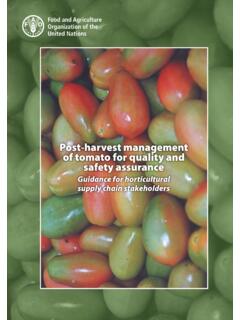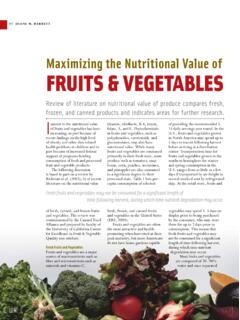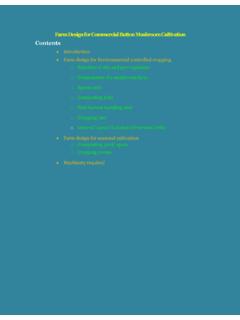Transcription of Fighting Food Loss and Food Waste in Japan
1 Fighting Food Loss and Food Waste in Japan 1 Fighting Food Loss and Food Waste in Japan Federica Marra s1154214 Supervisor: Prof. Dr. K. J. Cwiertka M. A. in Japanese Studies Asian Studies 2011 - 2013 Leiden University Word count: Abstract: Japan discards approximately 18 million tonnes of food annually, an amount that accounts for 40% of national food production. In recent years, a number of measures have been adopted at the institutional level to tackle this issue, showing increasing commitment of the government and other organizations.
2 Along with the aim of environmental sustainability, food Waste recycling, food loss prevention and consumer awareness raising in Japan are clearly pursuing another common objective. Although food loss and Waste problems have been publicly acknowledged only very recently, strong implications arise from the economic and cultural history of the Japanese food system. Specific national concerns over food security have accompanied the formulation of current national strategies whose underlying causes and objectives add a unique facet to Japan s efforts with respect to those of other developed countries.
3 Fighting Food Loss and Food Waste in Japan 2 Table of Contents Abbreviations and Acronyms p. 3 Introduction p. 4 Chapter 1 Combating Waste p. 7 Chapter 2 Improving the System p. 13 Chapter 3 Raising Awareness p. 20 Chapter 4 Securing Food p. 28 Conclusions p. 32 References p. 34 Fighting Food Loss and Food Waste in Japan 3 Abbreviations and Acronyms 2HJ Second Harvest Japan 3KH 3R Knowledge Hub 3Rs Reduce, Reuse, Recycle CAA Consumer Affairs Agency DEIJ Distribution Economics Institute of Japan DSRI Distribution Systems Research Institute EU European Union FAO Food and Agricultural Organization of the United Nations FY Fiscal Year GEC Global Environment Centre Foundation INTERFAIS International Food Aid Information System JIN Japan Information Network JORA Japan Organic Recycling Association JSWME Japanese Society of Waste Management Experts JW Japan Industrial Waste Information Center MAFF Ministry of Agriculture.
4 Forestry and Fisheries METI Ministry of Economy, Trade and Industry MEXT Ministry of Education, Culture, Sports, Science and Technology MHLW Ministry of Health, Labour and Welfare MIAC Ministry of Internal Affairs and Communications MoE Ministry of Environment NGO Non-Governmental Organization NPO Non-Profit Organization OECD Organisation for Economic Co-operation and Development UN United Nations UNEP United Nations Environment Project Fighting Food Loss and Food Waste in Japan 4 Introduction The issue of food losses and Waste has recently been given high visibility in the worldwide context due to their direct role in threatening environmental.
5 Social and economic According to the United Nations Food and Agricultural Organization (FAO) (2011), almost one-third of the food produced for human consumption worldwide is lost or wasted, corresponding to approximately billion tonnes per year. Food losses and Waste reflect food systems and food value chains that function poorly and cause a decrease in overall food availability. They therefore have important implications for poverty, nutrition and economic growth. Moreover, their impact on the environment and the climate is dramatic, considering the energy, biodiversity, greenhouse gases, water, soil and other resources embedded in food that are not ultimately eaten.
6 The fight against food losses and Waste is presented as essential for reducing the environmental footprint of food systems and improving global food security (UNEP 2012). 2 As a consequence of globalization, traded commodities that are wasted in one part of the world could affect food availability and prices elsewhere, making the consequences of food losses and Waste far from localized. Nevertheless, the circumstances under which food losses and Waste occur are strongly dependent on the specific food and Waste -related conditions in a given country each country having its own production, processing, distribution and consumption practices.
7 Low-income countries experience food losses and Waste mainly during the early and middle stages of the food supply chain. This happens as a result of managerial and technical limitations in the harvesting, storage, transportation, processing and cooling stages, each of these stages being affected by flaws in infrastructure, packaging and marketing systems. On the other hand, medium- and high-income countries Waste food mainly during later stages of the food supply chain since consumption and post-consumption food Waste account for the majority of the losses .
8 The main causes of this food Waste are policies and regulations ( quality standards, management regulations, and poor environmental conditions during display) and consumer behaviour ( excessive purchase, 1 Food losses refer to the decrease in the quantity or quality of edible food mass available for human consumption that can occur at early stages of the food supply chain ( production, postharvest and processing). Food Waste refers instead to food discarded at the end of the food chain ( retail and final consumption), resulting from decisions to discard food that is still valuable (FAO 2012a).)
9 2 Food security exists when all people, at all times, have physical, social and economic access to sufficient, safe and nutritious food which meets their dietary needs and food preferences for an active and healthy life. (FAO 2003, 29). Fighting Food Loss and Food Waste in Japan 5 lack of planning, misunderstanding of best-before dates, and leftovers) (Parfitt, Barthel and Macnaughton 2010). Japan , together with the United States and Great Britain are the three advanced economies at the top of the global food Waste list, each discarding 30-40% of their annual food produce (Melikoglu, Lin, and Webb 2013).
10 In 2010 it was estimated that Japan discarded approximately 18 million tonnes of food annually, of which 5 to 8 million tonnes were considered edible at the moment they were disposed of. This amount was virtually equivalent to the amount of the country s annual rice production ( million tonnes). 3 to 4 million tonnes came from the food industry and another 2 to 4 million from individual households; this is comparable to the total amount of food aid distributed worldwide (about 4 million tonnes).













